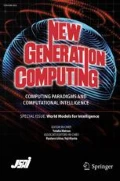Abstract
We present an improvement of SATCHMORE, calledA-SATCHMORE, by incorporating availability checking into relevancy. Because some atoms unavailable to the further computation are also marked relevant, SATCHMORE suffers from a potential explosion of the search space. Addressing this weakness of SATCHMORE, we show that an atom does not need to be marked relevant unless it is available to the further computation and no non-Horn clause needs to be selected unless all its consequent atoms are marked availably relevant, i.e., unless it is totally availably relevant. In this way,A-SATCHMORE is able to further restrict the ues of non-Horn clauses (therefore to reduce the search space) and makes the proof more goal-oriented. Our theorem prover,A-SATCHMORE, can be simply implemented in PROLOG based on SATCHMORE. We discuss how to incorporate availability cheeking into relevancy, describe our improvement and present the implementation. We also prove that our theorem prover is sound and complete, and provide examples to show the power of our availability approach.
Similar content being viewed by others
References
Stickel, M. E., “Upside-Down Meta-Interpretation of the Model Elimination Theorem-Proving Procedure for Deduction and Abduction,”Journal of Automated Reasoning, 13, pp. 189–210, 1994.
Demolombe, R., “An Efficient Strategy for Non-Horn Deductive Databases,”Theoretical Computer Science, 78, pp. 245–249, 1991.
Loveland, D. W., Reed, D. W., and Wilson, D. S., “SATCHMORE: SATCHMO with RElevancy,”Journal of Automated Reasoning, 14, pp. 325–351, 1995.
Manthey R. and Bry, F., “SATCHMO: A Theorem Prover Implemented in Prolog,”Proceedings of 9th International Conference on Automated Deduction, 1988.
Lloyd, J. W.,Foundations of Logic Programming (second edition), Springer-Verlag, Heidelberg, 1987.
Tamaki, H. and Sato, T., “Unfold/Fold Transformation of Logic Programs,”Proceedings of the Second International Conference on Logic Programming, pp. 127–138, 1984.
Chang, C. L. and Lee, K. C. T.,Symbolic Logic and Mechanical Theorem Proving, Academic Press, New York, 1973.
Loveland, D. W.,Automated Theorem Proving: A Logic Basis, North-Holland, Amsterdam, 1978.
Stickel, M. E., “Schubert’s Steamroller Problem: Formulations and Solutions,”Journal of Automated Reasoning, 2, pp. 89–101, 1986.
Author information
Authors and Affiliations
Additional information
This research is supported in part by the Japanese Ministry of Education and the Artificial Intelligence Research Promotion Foundation.
Lifeng He, Ph.D: He received the B. E. degree from Northwest Institute of Light Industry, China, in 1982, the M. S. and Ph.D. degrees in AI and computer science from Nagoya Institute of Technology, Japan, in 1994 and 1997, respectively. He currently works at the Institute of Open System in Nagoya, Japan. His research interests include automated reasoning, theorem proving, logic programming, knowledge bases, multi-agent cooperation and modal logic.
Yuyan Chao, M. S.: She received the B. E. degree from Northwest Institute of Light Industry, China, in 1984, and the M. S. degree from Nagoya University, Japan, in 1997. She is currently a doctoral candidate in the Department of Human Information, Nagoya University. Her research interests include image processing, graphic understanding, CAD and theorem proving.
Yuka Shimajiri, M. S.: She currently works as a Assistant Professor in Department of Artificial Intelligence and Computer Science at the Nagoya Institute of Technology. She received her B.Eng. and M.Eng. from the Nagoya Institute of Technology in 1994 and 1996, respectively. Her current research interests include logic programming and automated deduction. She is a member of IPSJ and JSAI.
Hirohisa Seki, Ph.D.: He received the B. E., M. E. and Ph.D degrees from the University of Tokyo in 1979, 1981 and 1991 respectively. He joined the Central Research Laboratory of Mitsubishi Electric Corporation in 1981. From 1985 to 1989, he was with the Institute for New Generation Computer Technology (ICOT). Since 1992, he has been an Associate Professor in the Department of AI and Computer Science at Nagoya Institute of Technology. His current research interests include logic programming, deductive databases and automated deduction. He is a member of ACM, IEEE, IPSJ and JSAI.
Hidenori Itoh, Ph.D.: He received the B. S. degree from Fukui University, in 1969, the M. S. degree and Ph.D degree from Nagoya University, Japan, in 1971 and 1974, respectively. From 1974 to 1985, he worked at Nippon Telephone and Telegraph Laboratories, developing operating systems. From 1985 to 1989, he was with the Institute for New Generation Computer Technology, developing knowledge base systems. Since 1989, he has become a professor at the Nagoya Institute of Technology. His current research interests include image processing, parallel computing, fuzzy logic and knowledge processing.
About this article
Cite this article
He, L., Chao, Y., Shimajiri, Y. et al. A-SATCHMORE: SATCHMORE with availability checking. NGCO 16, 55–74 (1998). https://doi.org/10.1007/BF03037320
Received:
Revised:
Issue Date:
DOI: https://doi.org/10.1007/BF03037320




